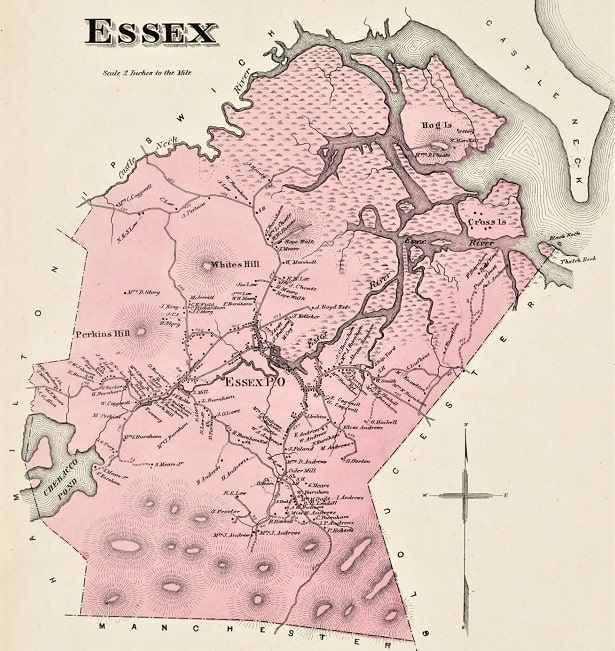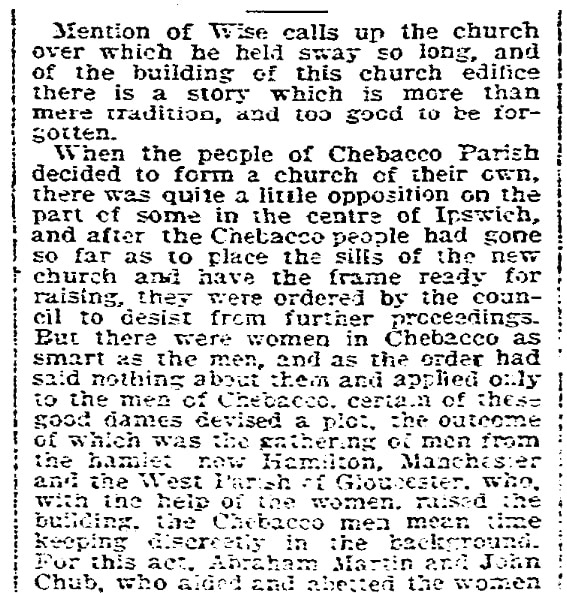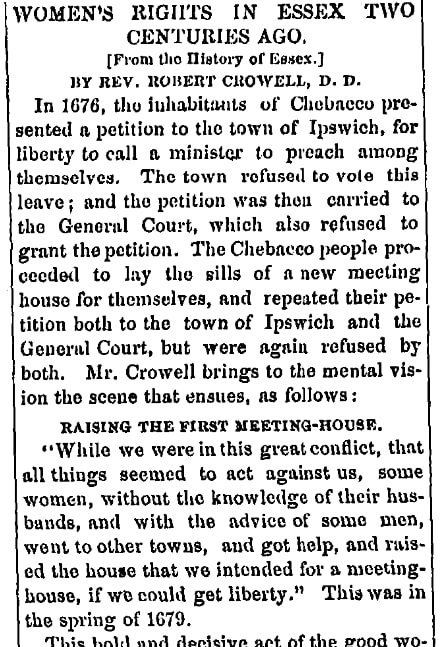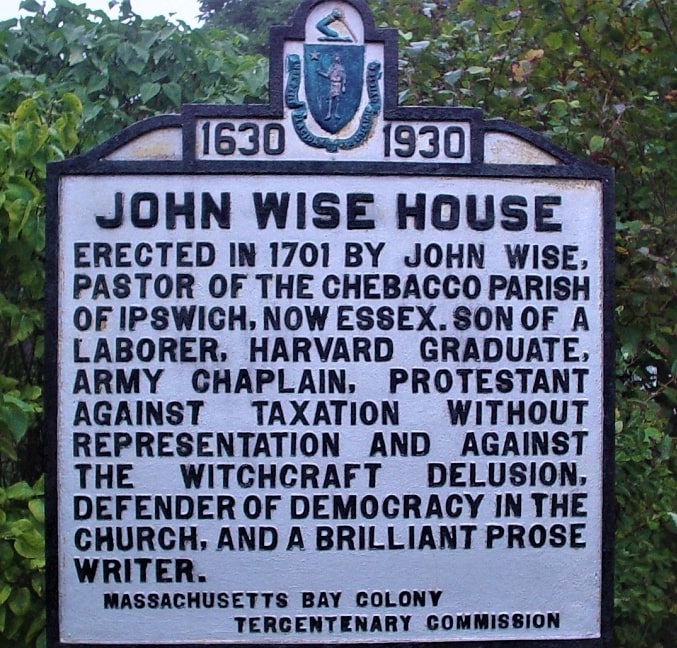Introduction: In this article, Melissa Davenport Berry tells a great tale: when the stuffy colonial authorities forbade the Chebacco men from building a new church but forgot to mention the women, three clever ladies took the initiative. Melissa is a genealogist who has a blog, AnceStory Archives, and a Facebook group, New England Family Genealogy and History.
From Our Honored Major General – To the Constable of Ipswich – You are hereby required to attach the body of Abraham Martin, and John Chub, and bring them before me on Tuesday next, about one o’clock, to answer for their contempt of authority in helping to raise a meeting house at Chebacco. You are also, at the same time, to bring with you the wife of William Goodhue, the wife of Thomas Varney, and the wife of Abraham Martin, for procuring, or abetting and encouraging, the raising the said house and so make return hereof under your hand. Spring, 1679.

The town of Old Essex, Massachusetts, (once known as Chebacco, a section of Ipswich), harbored three brave dames who outsmarted the magistrates of the high court and the church authorities to open a forbidden meeting house. The three rebels were: Hannah (nee Dane) Goodhue, wife of William, daughter of Rev. Francis Dane and Elizabeth Ingalls; Abigail (nee Proctor) Varney, wife of Thomas, daughter of John Proctor and Martha Harper and sister to John Proctor (who was hanged for witchcraft in 1692); and Hannah (nee unknown) Martin, wife of Abraham.
Apparently, an order was mandated that no man shall build a meeting house in Chebacco – but the magistrates never ordered that no woman could not. And so, legend and court records reveal how the three women cleverly used this loophole and organized a plan to erect a new house of worship.
I found a mention of this story in the Boston Herald.

This article reported:
Mention of Wise calls up the church over which he held sway so long, and of the building of this church edifice there is a story which is more than mere tradition, and too good to be forgotten.
When the people of Chebacco Parish decided to form a church of their own, there was quite a little opposition on the part of some in the centre of Ipswich, and after the Chebacco people had gone so far as to place the sills of the new church and have the frame ready for raising, they were ordered by the council to desist from further proceedings. But there were women in Chebacco as smart as the men, and as the order had said nothing about them and applied only to the men of Chebacco, certain of these good dames devised a plot, the outcome of which was the gathering of men from the hamlet of new Hamilton, Manchester, and the West Parish of Gloucester, who, with the help of the women, raised the building, the Chebacco men mean time keeping discretely in the background.
So, the three women were charged along with John Chub/Chubb, one of the selected builders, and Abraham Martin for aiding and abetting in their scheme. Of course, there were others.
This article further reported:
For this act [erecting the forbidden meeting house/church], Abraham Martin and John Chub, who aided and abetted the women in gathering the neighbors, and the wives of Abraham Martin, William Goodhue and Thomas Varney, were tried and found guilty of contempt of authority. The General Court, however, pardoned them, on their appearing in court and making a public statement to the effect that they were “sorry and would not do it again,” and so the case was dropped. But the women won, for the church people were granted permission to organize, which they did, with John Wise for their first pastor.
According to the “Records and Files of the Quarterly Courts of Essex County Volume VII,” the court listed John Gittings, Joseph Gittings, and Seth Story as being charged for their participation:
Seth Story was bound by Corp. John Andrews and Wm. Goodhue as sureties concerning action against him for building a meeting house. (p.183)
Chubb never really was one to succumb to the Puritan fold, and was always making the court docs, including dressing above his station in great boots. Here he is presented before the court for the building of the meeting house and “manifesting as much in his complaint to Mr. Wilson and Goodman Rust.” (p.187)
On 4 April 1679 the court records included the apology of the guilty party from a previous session:
We are convinced that we have offended in being active to erect a meeting house contrary to the advice and permission of the council for which we are sorry and desire to be forgiven. (p. 245)
Another account with some added color was published in the Gloucester Telegraph, written by Rev. Robert Crowell. This story is from a chapter in a book Crowell co-authored with David Choate and Edward Payson Crowell: History of Essex from 1634 to 1868.

Crowell’s narration tells us the women conspired to meet at Mrs. Varney’s, opposite the site of the planned, clandestine meeting house, which was Cogwell’s Field, known as Mr. J. P. Choate’s Lane at the time he was writing this story.
Draped in their hoods, they met in the home of Goodwife Varney “in her best room,” and with “eloquent tongue” they ironed out “various difficulties and objections in the way of their arduous enterprise.” The plan was hatched and, according to Crowell, here is how it went down:
…For, early on the next morning, Mrs. Varney, mounted on the old family horse, with Mrs. Goodhue behind, and their hired man Chubb, on another horse, to protect them, and Abraham Martin and his wife on another, were seen riding together, over the horse bridge, and returning before noon, with parties of men from Manchester, and the “precinct,” and conducting them to the timber in the corner of Mr. Cogswell’s field. Nothing is said by the Chebacco folks; but with great alacrity and cheer, their neighbors go to work, and join timber to timber, and fasten joint to joint, and soon a whole broadside is seen going up; and by and by another; and no stop, no stay till the ridge-pole is in its place, and then three hearty cheers indicate that the work is done. Many women upon horses had already arrived, with well filled sacks pending from their saddles, the contents of which they deposit at Mrs. Varney’s. Their kind neighbors from abroad are invited to the supper, without any other entrance fee than the good frame they have been in. The tables are spread with a good variety of edibles; among which there is plenty of good tongue. Chebacco men are scarce that day, so the good neighbors have to be thanked for their labor of love by the ladies alone.

The pastor appointed for the new meeting house was Rev. John Wise, a man who inspired the Declaration of Independence.
On 15 February 1680, one acre of ground was granted to Chebacco for a graveyard. Before 1680, inhabitants of Chebacco Parish were buried at High Street Cemetery, Ipswich.
Special thanks to Heather, my fellow genealogy peep: Nutfield Genealogy.
Explore over 330 years of newspapers and historical records in GenealogyBank. Discover your family story! Start a 7-Day Free Trial
Note on the header image: home of the Rev. John Wise, Essex, Massachusetts, erected in 1701. Courtesy of Digital Commonwealth: https://www.digitalcommonwealth.org/search/commonwealth:8s45qt44m
